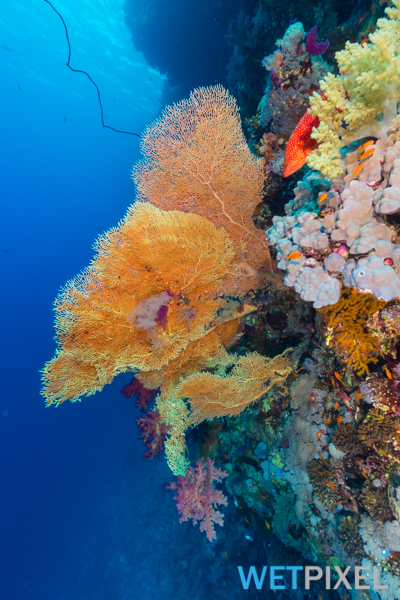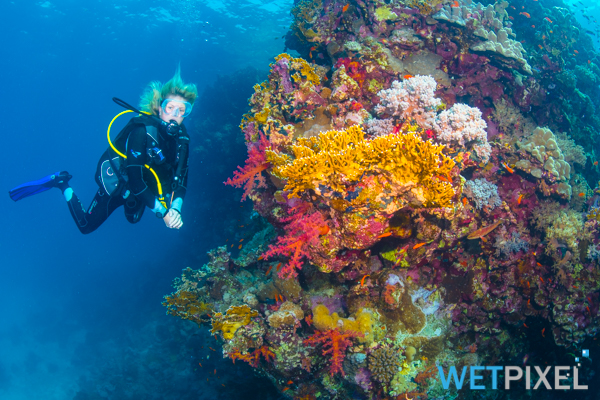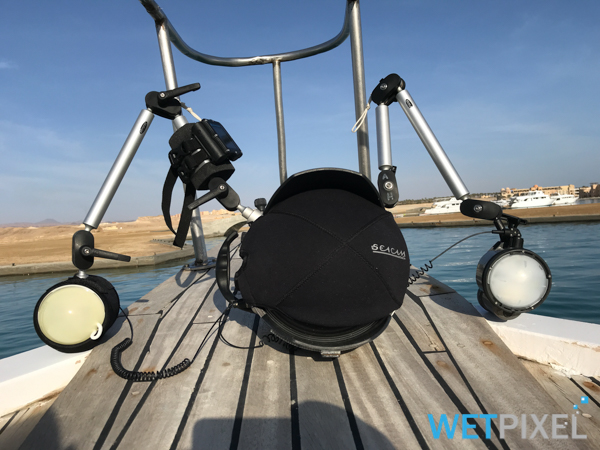Strobe tests: Inon Z330, Retra Flash and Symbiosis SS2

Power
There is a tendency among underwater photographers (and to some manufactures) to imagine that more power is always better. Land photographers shooting in a studio typically light their subjects solely with artificial light supplied by flashes or strobes. Hence power is arguably the most important criteria for a studio flash. However, underwater we both choose and are forced to either get very close to our subjects, or to balance ambient light with flash. Hence, to some extent, absolute power is desirable rather than a deal breaker.
There is a great deal of confusion around the terminology used to describe a flash’s power output. Some manufacturers express this as a guide number (GN). These are calculated thus:
GN = Subject Distance from Flash Source x f/Stop.
(With an industry standard of an ISO setting of 100.)
Whilst this should be an empirical test, it does not take into account whether the test is carried out in air or water, nor does it tell us anything about how wide the spread of the flash’s beam is.
Other manufacturers use a measurement of Watt/seconds (W/s). This is a direct measurement of the amount of luminous energy that the device puts out. For what it is worth, one Watt/second is equivalent to one joule. While this measurement will be the same in water as in air, it also does not take into account the beam angle of the flash. The other issue with it is that simply calculating the flash’s output based on the electrical energy used does not take into account the actual flash tube’s efficiency or any reflectors incorporated into the design.

Beam Angle
From a design point of view, in order to increase power, one approach is to focus the strobe’s output into a narrow beam of light. By concentrating it, it is easier to quote a higher power.
For most underwater use however, we want to spread the beam. So the ideal is typically a powerful strobe that also has a wide beam of light.
Conversely, we sometimes also want to control where the beam falls. Strobes which “spray” light everywhere inevitably mean that some of this light will light areas of the image that we do not wish to be lit. When shooting in challenging conditions with lots of particles in the water, being able to control what gets lit by the strobes is critical.
TTL
Underwater, “Through the Lens” flash metering has been around since the release of the Nikonos V camera in 1984. Broadly speaking, the idea is that the camera uses a pre-flash to register the effect of the flash on the subject, and then automatically adjusts the flash output to expose the image correctly.
More recent iterations have incorporated sophisticated sensing technology to provide an accurate exposure. This has also caused a few quirks that affect this. With a move away from electrical strobe connections to ones using opto-electrical converters and fiber optic cables, the transmission of the light signal must not be attenuated by the fiber. Typically, current guidelines suggest that using cables with a high number of fibers (often 613) along with providing each flash with an individual cable are needed to faithfully reproduce the TTL information produced by the TTL converter. Poor quality cables or dual cables may cause inconsistent results.
The other issue is one of compatibility. TTL converters are largely proprietary to specific strobe models. Some offer options for different strobes via the use of dip switch or jumpers. There is an inevitable delay while manufacturers produce firmware or hardware to support new strobe models.
A slightly different approach to automatic strobe exposure control is to build the sensor onto the strobe itself. The camera provides a trigger and the strobe measure the light bouncing back. This is then used to calibrate the flash’s output in subsequent pictures, by using the its output control. The idea is that once set, this correction remains constant.

Lastly, although TTL can be very accurate, there is no TTL circuit that inherently “knows” what the subject in a wide angle scene is, or how to light a complicated scene in which there are objects closer to the camera than the subject. Macro shooters are probably more able to control these variables, but often creative macro lighting involves using strobe positions creatively. Typically, TTL is challenged by this and can produce unreliable results.
Color Temperature
Typically cooler color temperatures penetrate further in water. Hence many strobes will compromise color temperature in favor of power.
The issue with this is that it tends to create a washed out effect with the deep blues in the water column. Cooler strobes produce (subjectively) a more pleasing color rendition. Whilst white balance can be adjusted in post, bear in mind that it is hard to do so without creating color casts elsewhere in the image.
Smaller strobes typically have a color temperature of around 5500°K. Blues are reproduced best at color temperatures of around 4600°K.
When shooting in green water and for macro subjects, arguably, color temperature is less of an issue.
Flash Tubes
Typically, strobes have either straight or circular flash tubes. It is easier to get more power from a straight tube, but round ones tend to produce a softer, more even light.
Usability
Most new strobes offer the option of fiber optical triggering. Some offer electrical triggering too. Other things to consider are mounting options, sync cable attachment, controls, battery compartment access, battery types, aiming lights and so on. While there is no doubt that good control layouts and the like will enhance productivity, factors like light quality and output will have more effect in terms of the quality of imagery produced.
Battery life
Broadly speaking, strobes are either powered by proprietary rechargeable battery packs, or by AA batteries. Of course the latter can be rechargeable and throughout the tests, Wetpixel used Panasonic Eneloop Pro rechargeable NiMh batteries.
Battery life is dependent on many factors, some of which are impossible to reproduce. In general terms, it is wise to swap batteries as often as is practical during a day’s shooting. You never know when you might need those few extra shots….
Recycle Time
Although it is rare, there is occasionally the need to shoot rapidly. When it is necessary, the capacitor in the strobe needs to refill. The faster it is able to draw current from the battery pack, the quicker it will recycle. Bigger components and more powerful battery packs typically provide faster recycle times.
Another possible issue with rapid recycle times is the dissipation of the heat build up caused by rapid firing.
Diffusers and accessories.
There is a current fashion to use dome shaped diffusers to soften and spread strobe output. In general, these do an excellent job of reducing harsh light, but the widening of the beam comes with some drawbacks. Typically, we seek to control the areas our strobes illuminate, and these diffusers tend to “spray” the light more.
Reverting back to the color temperature issues discussed above, one approach to cooler strobes is to use a diffuser to warm their output. This is typically at the expense of some power of course.
Strobes often develop an ecosystem of accessories that allow them to be customized for specific purposes or preferences.

- Introduction.
- Strobe Fundamentals.
- Inon Z330.
- Retra Flash.
- Symbiosis SS2.
- Test results and conclusion.